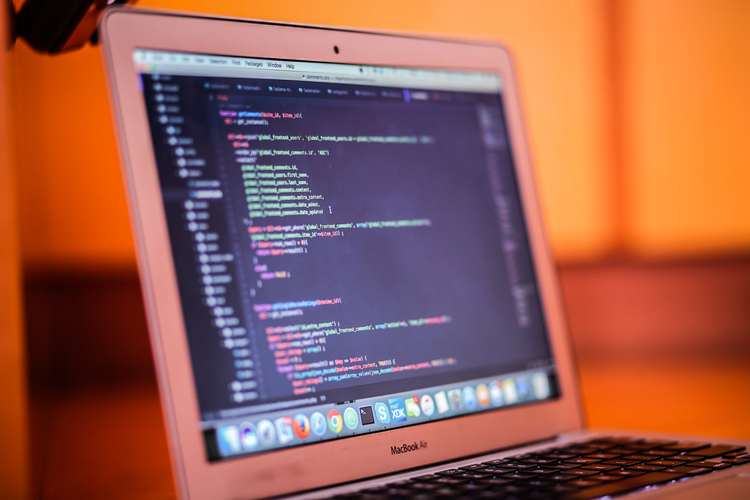
python怎么画人脸代码,OpenCV
1,介绍
开始之前,向大家提前说声抱歉,上一篇文章末尾提到了,在这篇文章将给大家介绍关于用 OpenCV 实现人脸融合技术,由于人脸融合技术所需的知识储备有点多,不只是之前介绍的的特征点提取,还有本文所提到的三角剖分,因此文章会向后面推迟一点,但请大家放心,人脸融合技术一定会在随后的几篇文章安排上日程。
看到标题里的两个词 Delaunay 三角剖分 和 Voronoi,估计第一次见到的小伙伴可能一脸懵(说的就是我自己),为了更直观地认识这两个概念,请看下图:
左图:68个人脸特征点 中图:Delaunay 三角剖分,右图 Voronoi 图表
左图是上篇文章提到的 68个人脸特征点标记,中图是基于左图的基础上对 68个点进行 点与点之间形成 Delaunay 三角剖分(德劳内),左图是基于中间图绘制的的 Voronoi Diagram (沃罗诺伊图)
2,Delaunay 三角剖分
Delaunay 三角剖分算法命名那个来源于俄国数学家 Boris Delaunay,该方法目的是最大化三角剖分中三角形中最小角,目的是避免“极瘦“的三角形的出现
Snipaste_2020-06-04_15-23-46.png
上方左图与右图的变换站示的就是 Delaunay 怎样最大化最小角,左右两图是对于四个顶点的两种不同的剖分方式;但左图中 顶点 A、C 不在三角形 BCD、ABD 的外接圆内,使得 角 C 非常大
右图对剖分形式有两个方的 改动:1,B、D 坐标右移;2,剖分线由 BD 变为 AC ;最后使得剖分后的三角形不那么”瘦“
3,Voronoi Diagram
Voronoi 命名同样也是来源于一个 俄国数学家 Georgy Voronoy,有趣的是 Georgy Voronoy 是 Boris Delaunay 的博士导师
Voronoi 图是基于 Delaunay 三角剖分创建,取 Delaunay 剖分的所有顶点,用线段连接相邻三角形的外接圆心,构成一个区域,相邻不同区域用不同颜色覆盖;Voronoi 图目前常用于凸边形区域分割领域
从下面20个顶点组成的 Voronoi 图种可以了解到,图中相邻点与点之间的距离是等长的
20个顶点构成的 Voronoi
4,OpenCV 代码实现
1,首先需要获取人脸 68 个特征点坐标,并写入 txt 文件,方便后面使用,这里会用到的代码
import dlib
import cv2
predictor_path = "E:/data_ceshi/shape_predictor_68_face_landmarks.dat"
png_path = "E:/data_ceshi/timg.jpg"
txt_path = "E:/data_ceshi/points.txt"
f = open(txt_path,'w+')
detector = dlib.get_frontal_face_detector()
#相撞
predicator = dlib.shape_predictor(predictor_path)
win = dlib.image_window()
img1 = cv2.imread(png_path)
dets = detector(img1,1)
print("Number of faces detected : {}".format(len(dets)))
for k,d in enumerate(dets):
print("Detection {} left:{} Top: {} Right {} Bottom {}".format(
k,d.left(),d.top(),d.right(),d.bottom()
))
lanmarks = [[p.x,p.y] for p in predicator(img1,d).parts()]
for idx,point in enumerate(lanmarks):
f.write(str(point[0]))
f.write("\t")
f.write(str(point[1]))
f.write('\n')
写入后,txt 中格式如下
image
2,利用图像大小创建一个矩形范围( 因为脸部特征点都是图中),创建一个 Subdiv2D 实例(后面两个图的绘制都会用到这个类),把点都插入创建的类中:
#Create an instance of Subdiv2d
subdiv = cv2.Subdiv2D(rect)
#Create an array of points
points = []
#Read in the points from a text file
with open("E:/data_ceshi/points.txt") as file:
for line in file:
x,y = line.split()
points.append((int(x),int(y)))
#Insert points into subdiv
for p in points:
subdiv.insert(p)
3,在原图上绘制 Delaunay 三角剖分并预览,这里我加入了动画效果 — 逐线段绘制(用了 for 循环)
#Draw delaunay triangles
def draw_delaunay(img,subdiv,delaunay_color):
trangleList = subdiv.getTriangleList()
size = img.shape
r = (0,0,size[1],size[0])
for t in trangleList:
pt1 = (t[0],t[1])
pt2 = (t[2],t[3])
pt3 = (t[4],t[5])
if (rect_contains(r,pt1) and rect_contains(r,pt2) and rect_contains(r,pt3)):
cv2.line(img,pt1,pt2,delaunay_color,1)
cv2.line(img,pt2,pt3,delaunay_color,1)
cv2.line(img,pt3,pt1,delaunay_color,1)
#Insert points into subdiv
for p in points:
subdiv.insert(p)
#Show animate
if animate:
img_copy = img_orig.copy()
#Draw delaunay triangles
draw_delaunay(img_copy,subdiv,(255,255,255))
cv2.imshow(win_delaunary,img_copy)
cv2.waitKey(100)
预览效果如下:
imag11252323.gif
4,最后绘制 Voronoi Diagram
def draw_voronoi(img,subdiv):
(facets,centers) = subdiv.getVoronoiFacetList([])
for i in range(0,len(facets)):
ifacet_arr = []
for f in facets[i]:
ifacet_arr.append(f)
ifacet = np.array(ifacet_arr,np.int)
color = (random.randint(0,255),random.randint(0,255),random.randint(0,255))
cv2.fillConvexPoly(img,ifacet,color)
ifacets = np.array([ifacet])
cv2.polylines(img,ifacets,True,(0,0,0),1)
cv2.circle(img,(centers[i][0],centers[i][1]),3,(0,0,0))
for p in points:
draw_point(img,p,(0,0,255))
#Allocate space for Voroni Diagram
img_voronoi = np.zeros(img.shape,dtype = img.dtype)
#Draw Voonoi diagram
draw_voronoi(img_voronoi,subdiv)
Snipaste_2020-06-04_14-43-10.png
4,小总结
Delaunay 三角剖分对于第一次接触的小伙伴来说可能还未完全理解,但这一剖分技术对于做人脸识别、融合、换脸是不可或缺的,本篇文章只是仅通过 OpenCV 的 Subdiv2D 函数下实现此功能,真正的识别技术要比这个复杂地多。
对于感兴趣的小伙伴们,我的建议还是跟着提供的代码敲一遍,完整代码贴在下面:
import cv2
import numpy as np
import random
#Check if a point is insied a rectangle
def rect_contains(rect,point):
if point[0]
return False
elif point[1]
return False
elif point[0]>rect[2]:
return False
elif point[1] >rect[3]:
return False
return True
# Draw a point
def draw_point(img,p,color):
cv2.circle(img,p,2,color)
#Draw delaunay triangles
def draw_delaunay(img,subdiv,delaunay_color):
trangleList = subdiv.getTriangleList()
size = img.shape
r = (0,0,size[1],size[0])
for t in trangleList:
pt1 = (t[0],t[1])
pt2 = (t[2],t[3])
pt3 = (t[4],t[5])
if (rect_contains(r,pt1) and rect_contains(r,pt2) and rect_contains(r,pt3)):
cv2.line(img,pt1,pt2,delaunay_color,1)
cv2.line(img,pt2,pt3,delaunay_color,1)
cv2.line(img,pt3,pt1,delaunay_color,1)
# Draw voronoi diagram
def draw_voronoi(img,subdiv):
(facets,centers) = subdiv.getVoronoiFacetList([])
for i in range(0,len(facets)):
ifacet_arr = []
for f in facets[i]:
ifacet_arr.append(f)
ifacet = np.array(ifacet_arr,np.int)
color = (random.randint(0,255),random.randint(0,255),random.randint(0,255))
cv2.fillConvexPoly(img,ifacet,color)
ifacets = np.array([ifacet])
cv2.polylines(img,ifacets,True,(0,0,0),1)
cv2.circle(img,(centers[i][0],centers[i][1]),3,(0,0,0))
if __name__ == '__main__':
#Define window names;
win_delaunary = "Delaunay Triangulation"
win_voronoi = "Voronoi Diagram"
#Turn on animations while drawing triangles
animate = True
#Define colors for drawing
delaunary_color = (255,255,255)
points_color = (0,0,255)
#Read in the image
img_path = "E:/data_ceshi/timg.jpg"
img = cv2.imread(img_path)
#Keep a copy around
img_orig = img.copy()
#Rectangle to be used with Subdiv2D
size = img.shape
rect = (0,0,size[1],size[0])
#Create an instance of Subdiv2d
subdiv = cv2.Subdiv2D(rect)
#Create an array of points
points = []
#Read in the points from a text file
with open("E:/data_ceshi/points.txt") as file:
for line in file:
x,y = line.split()
points.append((int(x),int(y)))
#Insert points into subdiv
for p in points:
subdiv.insert(p)
#Show animate
if animate:
img_copy = img_orig.copy()
#Draw delaunay triangles
draw_delaunay(img_copy,subdiv,(255,255,255))
cv2.imshow(win_delaunary,img_copy)
cv2.waitKey(100)
#Draw delaunary triangles
draw_delaunay(img,subdiv,(255,255,255))
#Draw points
for p in points:
draw_point(img,p,(0,0,255))
#Allocate space for Voroni Diagram
img_voronoi = np.zeros(img.shape,dtype = img.dtype)
#Draw Voonoi diagram
draw_voronoi(img_voronoi,subdiv)
#Show results
cv2.imshow(win_delaunary,img)
cv2.imshow(win_voronoi,img_voronoi)
cv2.waitKey(0)
参考链接:
 //
//